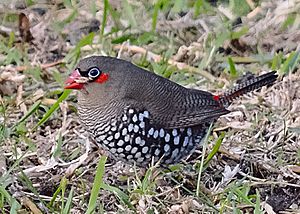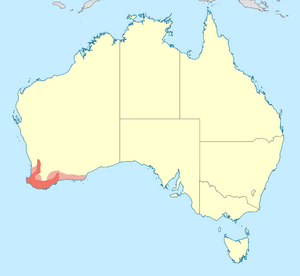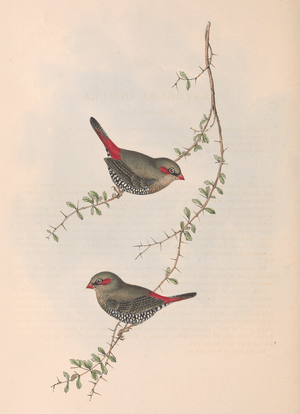Red-eared firetail facts for kids
Quick facts for kids Red-eared firetail |
|
|---|---|
 |
|
| Conservation status | |
| Scientific classification | |
 |
The red-eared firetail (Stagonopleura oculata), also called the boorin, is a small bird. It looks a bit like a finch. This bird lives in thick, wet areas near the coast in Southwest Australia.
People think the red-eared firetail looks very nice. It has white spots, black stripes, and bright red marks near its ears and on its upper tail. These birds are usually hard to see because they move quickly and quietly through their homes. You might hear their soft calls or see them fly away if you disturb them.
Male and female red-eared firetails look similar. They stay together as a pair for their whole lives. They defend a small area around their nest. This bird is similar to the beautiful firetail found in eastern Australia. However, red-eared firetails usually stay in pairs and are rarely seen in large groups.
It is rare to keep red-eared firetails as pets. They need special care and a large home to stay hidden. But, watching them in captivity has helped scientists learn more about their behavior. Even though they are shy around other birds and people, they can be less shy when visiting bird feeders. It is hard to confuse this bird with others in its natural home. Only the red-browed finch (Neochmia temporalis), which has escaped from captivity, looks a bit similar.
Contents
About the Red-eared Firetail
The red-eared firetail was first described by French zoologists Jean René Constant Quoy and Joseph Paul Gaimard in 1832. They gave it the scientific name Fringilla oculata. This name was published after they found a bird in King George Sound.
The word oculata means "marked with eyes" or "conspicuous" in Latin. Early scientists thought it meant the white spots looked like eyes. But Quoy and Gaimard likely meant "conspicuous" because of the bright red patch near the bird's eye.
People in the Nyungar language used to call this bird boorin, dwerdengolngani, and djiri. Other common names include Western firetail and red-eared finch. The official name recommended today is "Red-eared Firetail." Early settlers in the Swan River Colony called it the "native sparrow." Some people also called it the "casuarina finch" because it likes to eat seeds from sheoak trees.
The red-eared firetail belongs to the finch family called Estrildidae. This family is part of a larger group of birds called Passeriformes, which are perching birds.
What the Red-eared Firetail Looks Like
The red-eared firetail is a small grass-finch. It has black stripes and white spots on its feathers. You can easily spot it by its bright red beak, black mask around its eyes, and a vivid red patch behind its eye and on its rump.
The feathers on its upper body are olive-brown. Its chest is buff-brown, both with thin black stripes. White spots appear on its darker lower body. Female birds look very much like males. However, the male's colors become brighter during the breeding season.
Adult birds have wavy black lines on their feathers. These lines are fine on the back of the neck and head. They are stronger on the shoulders, upper wings, back, and mantle. These black marks are on grayish-brown upper parts. Similar dark black patterns are finer on the brown throat and cheek. They are bolder on the grey-buff foreneck.
The feathers on the lower body, like the undertail, belly, and sides, are white with black edges. They also have distinct spots. The light brown thigh has some black stripes. Lighter lines cross the brown feathers under the tail. The secondary flight feathers and their covers are grayish brown with grey-black stripes. The main flight feathers are dark brown.
A deep red color is seen on the rump and tail feathers. A thin black band goes across the forehead. It gets wider near the eyes, making the bird look like it's wearing a mask. This mask contrasts with the bright red patch at the ear and the scarlet beak. The male's mask is bigger when you look closely. The tail feathers are dusky brown with fine black stripes. The central tail feathers turn crimson near the body.
The bird's eyes can be red or dark brown. The ring around the eye is pale blue. Its legs are dark or pink-brown. Both sexes have a red beak. However, the male's beak color gets stronger during the breeding season.
An adult red-eared firetail is about 125 millimeters (5 inches) long. Males weigh between 11.4 and 16.0 grams. Females are a bit lighter, weighing 12.5 to 13.6 grams.
Young red-eared firetails look similar to adults. But they do not have the deep red ear patch or spotted belly. The white spots appear first, starting at the sides. The red ear is the last feature to show up. The wavy black lines of adult feathers are missing on the neck and head of young birds. They are also less clear on the rest of the upper body. The black around the eyes is missing or very faint. The bright red on the upper tail and rump is duller. Their lower parts are lighter, buff-colored, and mottled instead of spotted.
Young birds usually get their adult feathers within four months. But this can take longer if they are born late in the breeding season. A young bird's beak starts as brownish-black. It turns scarlet about two to three weeks after it leaves the nest.
The eggs are pure white, smooth, and finely textured. They do not shine. The contents inside give them a salmon-pink tone. Eggs are typically about 16.6 mm by 12.4 mm in size and oval shaped.
Where They Live and How They Live
The red-eared firetail eats seeds. It is usually quiet and prefers to be alone, which is unusual for an Australian grass finch. This bird often stays hidden in thick plants while looking for food low to the ground. You might know they are there by their special calls. They are most often seen perched high on a tree branch.
These birds form pairs instead of large groups. Each pair has an area about 100 to 200 meters wide. They might join other pairs when feeding if their areas overlap. They only strongly defend their nest site. Young birds are eventually chased away from the nest.
The red-eared firetail's conservation status is currently "least concern," meaning it is not threatened. Its habitat has been affected by farming and water changes. However, these birds can still live in suitable areas. Their population is thought to be stable.
Where They Are Found
The red-eared firetail lives only in the southwestern part of Australia. It is not very common, but you might find many in places that have not been disturbed. These places are usually thick forests and dense heathlands near valleys, rivers, and swamps. More birds live closer to the coast, especially in the south.
Their range extends along the southern coast past Esperance to the east. From the southern coast, they are found as far north as Cape Naturaliste, Bridgetown, and the Stirling Range. They also live on Bald and Coffin Islands near Albany.
The species is believed to breed throughout its range. However, breeding has only been recorded in areas west of 120° East longitude. While they usually stay in one place, adults might move outside their breeding area in certain seasons. Young birds might also be forced to new places.
Changes in land use, like clearing land near water, have made the species disappear from some areas. In 1848, the bird was "abundant" around the Swan River colony. But by the mid-1900s, it had disappeared from areas near Perth.
Their Home
The red-eared firetail lives in thick plants in forest undergrowth, paperbark swamps, heathland, riverbanks, and valleys. The trees in their home include eucalypts like Eucalyptus marginata (jarrah), Eucalyptus diversicolor (karri), and Corymbia calophylla (marri). They also live among Allocasuarina (she-oak) and Melaleuca (paperbark) trees. They need tall forests nearby. If native trees are replaced by pine plantations, the birds may disappear.
They often live where there is sedge like Lepidosperma tetraquetrum and sheoak species like Allocasuarina fraseriana. The seeds from these plants are a favorite food. In karri forests, which have tall eucalypts, the boorin likes the thick bushes under these giant trees.
They also live in sheoak stands and paperbark swamps in jarrah forests. You might also find them in wet heathlands with tall shrubs. Sometimes, they are seen in gardens, parks, and along forest paths.
The red-eared firetail has a similar role in nature to the beautiful firetail (Stagonopleura bella) in their different areas.
Who They Hang Out With
Scientists have noted that red-eared firetails are usually solitary or stay in pairs. This is different from the beautiful firetail, which is more social. Sometimes, a few young birds might be seen together, perhaps after being driven from their parents' territory. Pairs stay together for life.
Even though they are shy in their natural home, red-eared firetails have been seen feeding with other birds. These include Western rosellas (Platycercus icterotis) and splendid fairywrens (Malurus splendens) in parks and gardens. They are known to visit bird feeders at tourist spots.
How They Behave
The first detailed study of the red-eared firetail was by John Gilbert. His notes, published in 1865, have been found to be very accurate. Gilbert described the bird as "solitary" and found in "thickets." He noted its "mournful, slowly drawn-out note." He also mentioned a local story about the bird getting its red beak from spearing a dog.
A key study in 1960 by Klaus Immelmann at Wungong Gorge helped us learn a lot about their feeding and breeding habits. Breeders who keep these birds have also shared important observations.
Immelmann noted that these birds are very good at moving through thick plants. They hop sideways along branches. They can move quickly and skillfully through dense leaves when going downwards.
You usually see red-eared firetails when they are disturbed. They will fly to a high perch and call briefly. Then they move to another part of their territory. In captivity, they are mostly secretive and get nervous around strangers. But they will get used to a familiar person. They might tap their beak on branches when observed closely. They are most active in the early morning, moving and calling. They are also curious about new things in their cage.
What They Eat
Red-eared firetails usually avoid the ground when feeding. They prefer to perch on lower branches or fallen twigs. They get seeds from grasses by bending the stem with their beak. Then they use their foot to pull the seedhead through their beak. They then let go to get the next stem. For taller plants, they perch close and take the seeds directly. If they do go to the ground to feed, they use their foot and beak to bend grass. Then they often fly back to a higher spot to look around.
They especially like seeds from sedge species like Lepidosperma (Lepidosperma tetraquetrum and Lepidosperma squamatum). But they will also eat seeds from other plants in their home. They also like seeds from Bossiaea plants and the cones of Allocasuarina trees.
In captivity, they eat green leaves. They also like seeds from Lepidosperma gladiatum. They can twist open the tough casing of these seeds with their heads. They are attracted to seeds in bird feeders in gardens and parks. They usually visit these areas alone or in pairs, sometimes with other bird species.
How They Communicate
Red-eared firetails have about five different calls. These calls are usually quiet, so you can only hear them nearby. Calls at the nest are very soft.
One important call is their "identity call." It sounds like a long oowee. This call makes it hard to tell where the bird is coming from. The bird makes this call with little movement, except at its throat. It might call once or up to twenty times in a row. This call helps partners find each other in their territory, especially when not breeding. The calls are repeated by their mate after a few seconds.
Another call is an "intimate nest vocalization." The parent arriving at the nest makes a twit-twit sound with a closed beak and twitching wings. The bird inside the nest replies with a drawn-out tweet and sharp tit-tit-tit.
There is also a "nest site call." This might start with a shorter, richer oowee. Then it has five quick notes of u-u-u-u-u. A very soft huh-huh-huh sound is also reported in captive birds.
A very quiet "conversation call" has been heard in captive birds. You can only hear it if you are very close. It sounds like qwirk or qwark. There is also an "alarm call" when they feel their young are in danger. It sounds like a mother hen being taken from her nest. Young birds make a grating sound when they want to be fed. They also make a repeated chik sound to their parents.
The song of captive birds, when courting or alone, starts with a flute-like whistle. It has four loud pulses and ends with repeated grasping sounds.
Life Cycle and Reproduction
Red-eared firetails find a partner in their first year. They stay together for their whole lives. The breeding season is from October to November, sometimes lasting until January.
The nest is carefully and tightly woven from grass. It is strengthened with green plant tips, making a strong, round shape that often faces downwards. The red-eared firetail's nest is the largest among Australian grassfinches.
A female lays between four and six eggs. The eggs hatch after about 14 days. Both parents share the job of sitting on the eggs equally. They take turns every 1.5 to 2 hours. Each shift starts with a special "intimate nest call" between the parents. When the male takes his turn, he might bring a feather to the nest. He continues this for about eight days after the eggs hatch.
After the eggs hatch, the parents remove the shells from the nest. They drop them about 30 to 40 meters away. Young birds stay in the nest until they are ready to fly, which is about two to three weeks. Both parents continue to care for and feed them after they leave the nest.
The male bird chooses a nesting site. He tries to attract a female with a special display. He puffs up his feathers and makes his identity call. He also hops around the branches. He might do this for up to 45 minutes. He might even hold a long piece of grass (20-45 cm) in his beak. This grass is a symbol of building a nest and mating. He dangles the grass as he shows the female the possible nest site. If the female is interested, she will check out the area. The male then drops the grass and makes his nest site call. If she likes the spot, she moves closer. If not, she leaves to wait for another proposal.
Nests are often hidden high in tall trees like marri, jarrah, or yate. They can also be in the branches of shrubs like melaleuca, hakea, or banksia, or among vines. Nests are often shaped like a bottle or sphere, with a long, narrow entrance that points downwards.
The nest is mostly built from fresh grass stems. The male cuts the stems and brings them to the female, who builds the nest. At the busiest time, a male can bring one stem every 30 seconds. The inside of the nest is lined with feathers and other soft plant material. It has two parts, with a finer, cup-shaped nest inside. Building these nests takes a lot of energy and time for such a small bird. Some nests have over a thousand pieces of material!
Red-eared Firetails in Captivity
The red-eared firetail is considered a beautiful but challenging bird to keep in captivity. They are rare and expensive. You usually need special permits to keep them, often only for research. They tend to stay hidden in large, complex aviaries that look like their natural home.
The first record of these birds in captivity was in 1938. A man named H. V. Highman from Perth kept three pairs in a very large aviary. He even sent eight pairs to Germany in 1933.
Mating pairs need their own large aviary with trees that are at least 2.5 meters tall. Aviaries that have trees and shrubs like Kunzea, Callistemon, Grevillea, or Melaleuca have been successful for breeding pairs.
The breeding season in captivity can be from July to January. During this time, mating pairs become more aggressive towards other birds. Males can be told apart from females by the deeper red color near their ears before breeding.
The species has been bred in captivity since 1938. A Western Australian bird expert, Alwyn Pepper, started a breeding program in 1962. He used eggs from a fallen nest. He had Bengalese finches raise the young. This led to a successful breeding pair within the first year.
The Perth Zoo also started a breeding program in the 1980s. They used four birds to produce forty more. Some of these birds were sent to other bird experts.
The red-eared firetail is not suitable for most bird keepers. This is because they are expensive and need a lot of space and special care. Their secretive habits also make them hard to show in zoos. As of 2011, there were only 38 red-eared firetails recorded in captivity in Australia.
Images for kids
See also
 In Spanish: Diamante orejirrojo para niños
In Spanish: Diamante orejirrojo para niños









